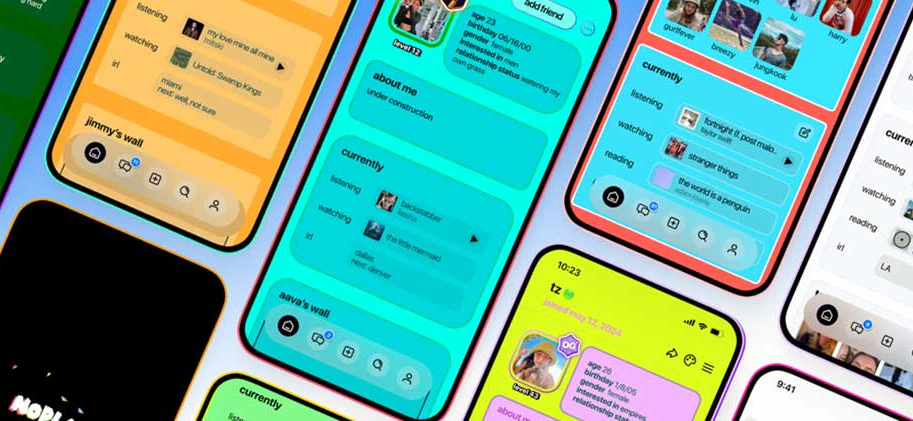Bilgiler28th Jul 2024
Social… in the New Communications Economy
In the fourth of our article series, Michael Consagra – Global Head of Creative Strategy – explores the evolution of social media, and why brands need to keep up with changing user behaviour to successfully tap into these channels.
Earlier this year, the platform that introduced the masses to ‘social networking’ quietly celebrated a sobering milestone… its 20th birthday. Facebook might no longer be the standout social platform, but it still claims the most users globally. Since its inception, I’m struck by how much ‘social’ has changed.
From the halcyon days of Myspace to the TikTok era, today’s platforms have become complex ecosystems, influencing culture, politics, and commerce. However, ‘paid media’ remains mostly one-dimensional, certainly not keeping pace with the transformation we've seen from platforms and users.
The past, present and future of social media
Social media is now old enough to be considered ‘vintage’. Its continual rebirth in new platforms and features marks core shifts in functionality and focus. We have moved from connection and sharing to content consumption to global community-building. Who says 20-year trend cycles are dead?
Social is now the largest ‘channel’ in the world for ad spend. Meta alone is on track to surpass linear TV’s global ad revenue by 2025. But today’s social spend focuses on interruption over integration: branded advertising can get in the way of consumers set on connecting with each other, or seeking hyper-specific content.
Connection
I’m a child of the Myspace generation. Or the “thank goodness most evidence has now been deleted from the internet” generation. This social media was, first and foremost, a digital extension of your real life, for connection with physical contacts, direct communication and self-expression.
Digital connections were built through the act of sharing; helping us understand our connections better and strengthen relationships. At first, our self expression was predominantly text-based, but platforms evolved to spotlight photo sharing and albums, prompting Instagram and Snapchat’s highly visual formats. Recently, Instagram brought back profile songs, a personal favourite from the Myspace era.
But sharing is far from the primary focus for modern users: 61% post less than they used to, happy to leave the content creation to creators. Most of us are happy to sit back and take it all in, to follow, to consume.
Consumption
Facebook signalled the first major shift in behaviour with the ‘News Feed’, aggregating content from friends’ pages into a single stream. Next, Twitter/X launched its microblogging format, allowing users to broadcast short messages to the world to encourage user interaction and content sharing. These platforms set the stage for a more interconnected and real-time online experience.
However, it was phones that transformed social into a primary source of entertainment. Content consumption on-the-go, fed by algorithmic feeds, prioritised engaging and shareable content. Influencers, content creators and brands are major players in this social media landscape. Overnight, social media became less social and more media.
For our industry, this meant a ‘media channel’ to ‘tell brand stories’, rather than a hub of connection.
Community
Throughout human history, we have formed communities. On social, features like Facebook Groups or Twitter hashtags supported group interactions, building broader, interest-based connections beyond users’ immediate circles. These communities reflect a shift from purely personal use to more collective and purpose-driven engagement.
The Global communities growing around content and issues are the new mass media. 76% of people now belong to an online sub-culture, and 80% of Gen Z associate more with digital communities than physical ones. #RunTok videos amass 2 billion views, 32 million watch #GirlsWhoLift, and 2 million follow a Woodworking subreddit. Brands can reach and drive relevance with hyper-engaged audiences, and we can find new audiences at scale like never before.
The latest platform to get GenZ’s attention was built with this in mind. NoPlace aims to “bring the social back to social media”, fostering new connections around shared interests. It shot straight to No.1 in the App Store. Billed as the new Myspace, I obviously ran to download it.
As platforms continue to evolve and new online spaces emerge, the meeting places for these communities will change. But they’ll take the brands they love with them, with community ringleaders (content creators) showing the way.
Platforms, people and publishers
Communities revolve around the platforms, people and publishers that fuel them. With this in mind, we can triangulate and target communities in a more authentic, credible, and less intrusive way. With the right creative engine, it offers both reach and relevance in one.
Social is an important channel, but brands must look beyond the distribution of brand-generated ‘creative’. How might paid-for partnerships with platforms, people and publishers play a role in engaging social audiences? Could the budget be better spent amplifying those partnerships?
Paid media and advertising is critical, but spending almost the entirety of our social budgets on it simply can’t continue. In two decades, social media user behaviour has transformed beyond recognition. Our marketing strategies have to evolve, too.
